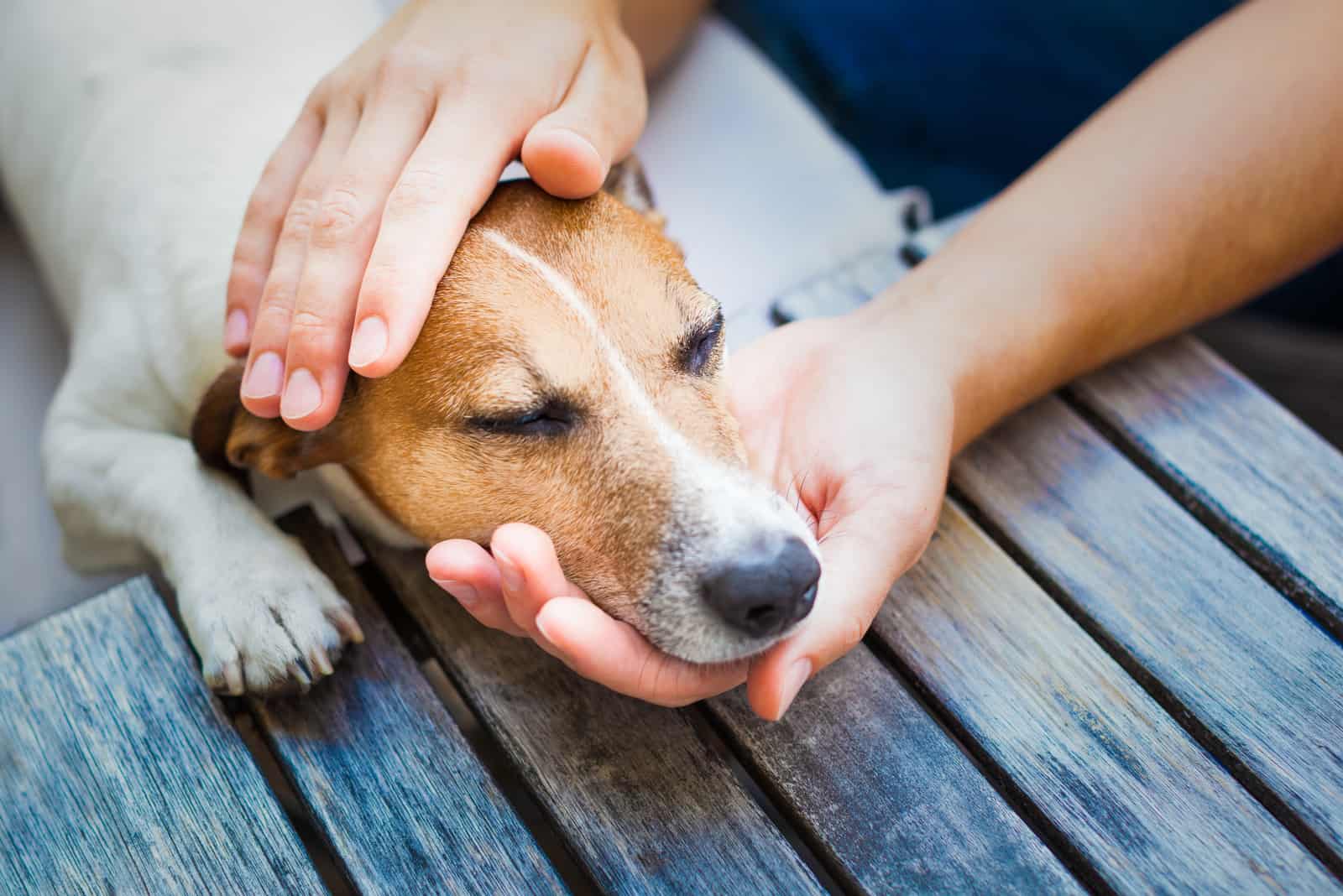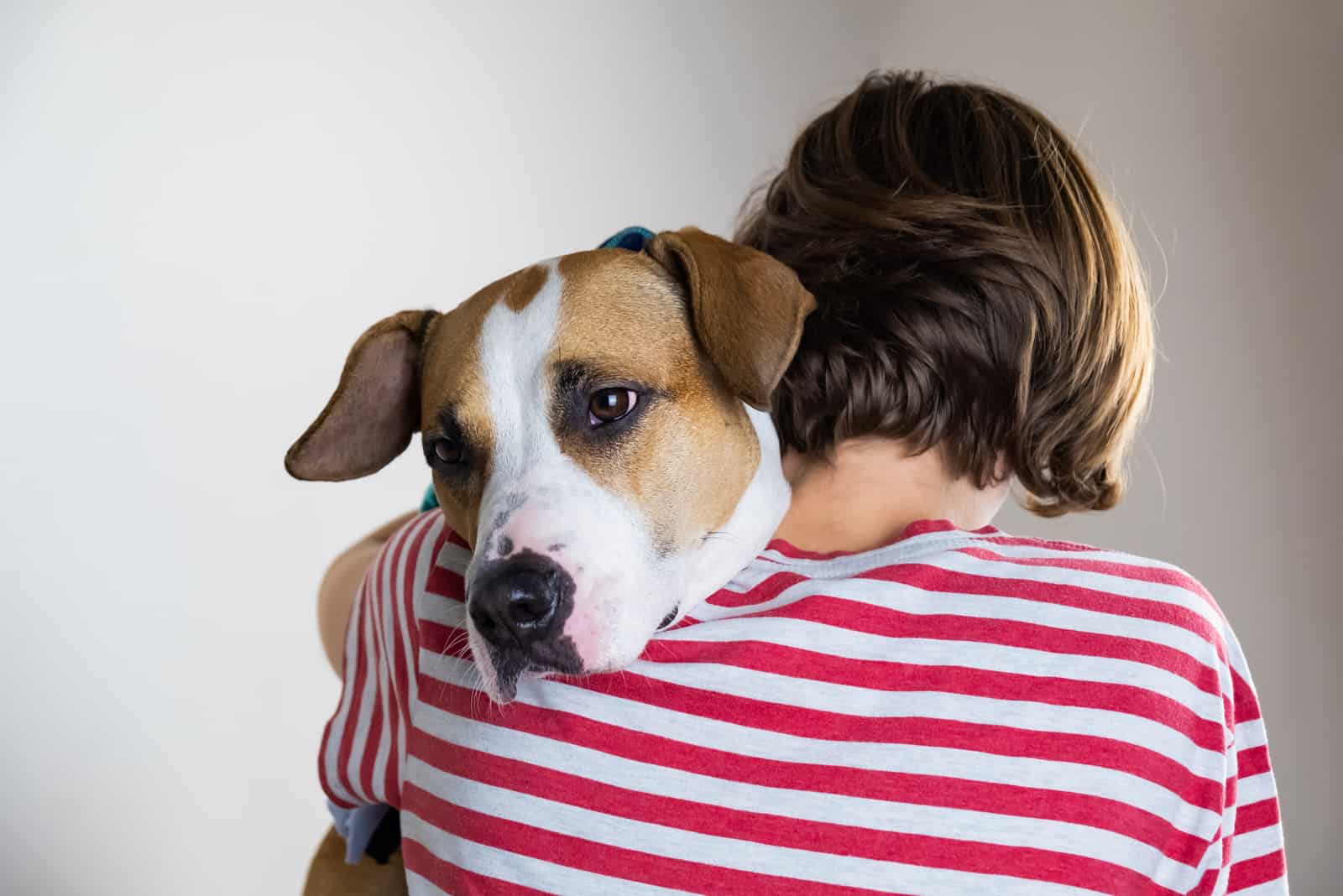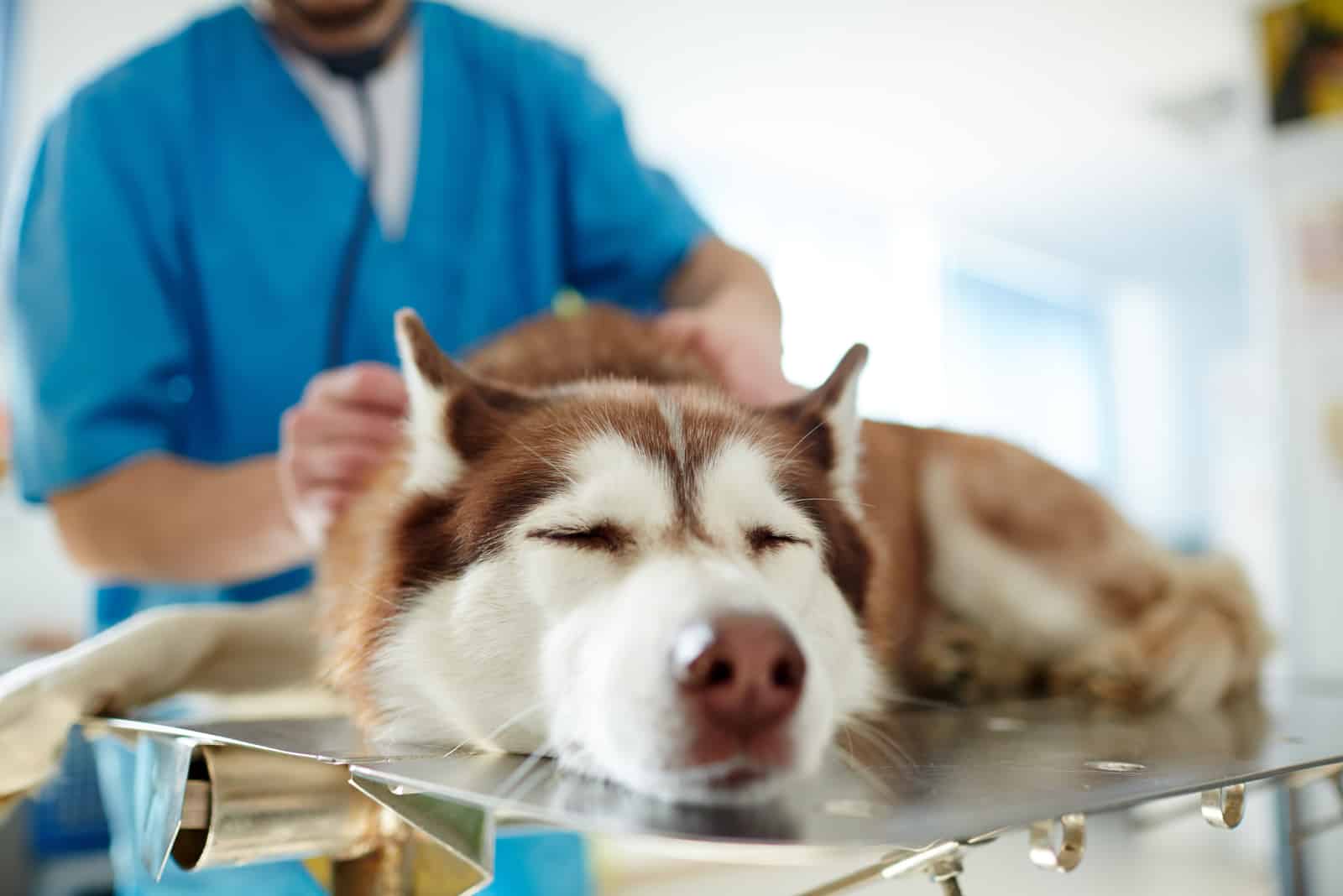It’s not as challenging to recognize the signs a dog is dying as it is difficult to come to terms with your pup passing away.
Once the tail stops wagging and the eyes stop shining, you’ll know that the end is near, but many won’t have the courage to admit that this is it.
This article’s primary purpose is to help you accept all the symptoms and get through the whole process more quickly, if that’s possible.
What Are The Last Signs A Dog Is Dying?

Dogs typically display a variety of common signs that indicate the end of their lives is drawing close. These signs include things like lethargy, a decreased appetite, and an increased desire for human comfort than is typical for them.
During this period, you’ll want to show your dog an abundance of compassion and work closely with your veterinarian to ensure that the pup experiences as little discomfort as possible. This includes making the decision as to whether or not euthanasia is more suitable than a natural death.
As a pet parent, it is essential to take care of your own emotional, spiritual, and physical well-being, while providing special treatment for your companion. You also need to allow yourself more than enough time to mourn after the loss of your household pet.
15 Signs A Dog Is Dying

1. Anxiety And Depression
Pups that are in the end stages of their life will frequently exhibit several symptoms of depression and anxiety.
This is not always because your canine is aware that they are nearing the end of their life. Instead, it might be that the canine isn’t feeling at all well just at this moment.
It’s possible, for instance, that your pet:
• Won’t take part in the activities that it used to enjoy
• Will stop reacting to your support
• Will turn inward and retreat
• Will exhibit changes in their typical sleeping patterns
• Will lose interest in going for walks or to the playground
Although depression in dogs can generally be treated, it might be more challenging to successfully do so when your dog is entering the final phase of their life.
Some depressed pups are treated with medicine, but if your dog is really old, the medication might not work as effectively for them as it would for a younger dog. It is essential to discuss your choices with your trusted veterinarian.
2. Lack Of Balance
When canines reach the later stages of their lives, it is pretty common for them to experience a loss of coordination. They might not have the same level of muscle strength as they once did, which might make it more difficult for them to maintain their balance.
In addition to this, some pups can have a difficult time estimating the distance from one place to another or they might experience vision problems that can affect their quality of life. Because of these circumstances, they could become more clumsy than usual.
Dehydration is just one of the many conditions that might contribute to a lack of coordination; there might be other causes as well, although they’re less common.
Your canine companion may be suffering from dehydration if they’re showing signs of gastrointestinal distress and a loss of coordination.
But, if your pet is exhibiting more than one of these symptoms, this is a cause for concern.
3. Lower Appetite
A shift in appetite is typical in older dogs, particularly those that are getting close to the end of their lives. They might even quit eating altogether, which is the most common cause of rapid weight loss. This would be considered an extreme measure.
When they are uncomfortable, dogs will frequently refrain from eating, just like humans.
If they also have issues with their gastrointestinal tract, they may have less of an appetite, due to the fact that they simply do not feel well.
However, a lack of appetite is not necessarily a warning of impending mortality in dogs.
Alterations in appetite are a symptom of almost all diseases, in addition to being a common response to stress.
The most worrisome symptom, and the topic of discussion here, is a loss of appetite that cannot be explained. Alterations could also be present in the frequency with which your dog drinks water.
4. Incontinence
Incontinence on its own is not generally a warning indicating your dog is going to pass away in the near future. Instead, it may be merely a natural part of their process of aging and contribute to a lower quality of life.
However, suppose incontinence arises suddenly and is accompanied by some of the other signs from this article. In these cases, it may be an indication that your pet’s system is starting to shut down and is approaching the end of the road.
If, despite having mishaps, your canine is still bouncing around and enjoying their life, it is quite unlikely that the end of his life is close at hand.
If your companion has lost control over their bladder, you should definitely take him to the veterinarian as soon as possible. Incontinence is a symptom that can be indicative of a wide variety of underlying health conditions, many of which are curable.
If your veterinarian has not told you otherwise, ensure that your pet always has access to a sufficient amount of clean drinking water at all times.
5. Aggressiveness

It is very probable that your canine will not feel well as they get close to the end of their life, which may cause them to become quite agitated.
The canine may burst out of nowhere, have an adverse reaction to activities that they used to be able to accept, or growl for no reason at all.
This is a common reaction to anxiety and pain.
If your pet is experiencing discomfort, they could be scared that physical touch will worsen it.
For example, the canine may be nervous about you touching the place that hurts or they may not be comfortable with being touched at all.
As a result of this, they might try to shield themself by being angry and rather aggressive in an effort to defend themself.
On the other hand, if your dog still has enough strength to be irritated despite being sick, there is a chance that they are not as near to passing away as you might fear.
Breeds such as Chihuahuas, Belgian Malinois, and German Shepherds are generally known to be aggressive, so it might not be easy to detect aggressiveness as a symptom in their cases. However, if a French Bulldog displays such a sign, this can be a reason for immediate concern.
Dogs who are on their last legs tend to lack energy and be sleepy rather than irritable when they are in the later stages of life.
It should go without saying that you should consult your canine’s veterinarian if you observe any substantial behavioral changes in your dog.
6. Loss Of Enthusiasm And Curiosity
Once a canine becomes older and closer to the end of their time, their motivation for life and the interest in the things they loved before will diminish greatly.
This is also the case for canines who’ve been suffering from a condition that lasts for a longer period and is chronic.
Toys that your pet used to be passionate about will eventually fall into neglect, and they might not show the same amount of excitement when seeing you walk through the door.
Actually, these seem to be the primary indicators that your furry friend is growing old and coming to the end of their life.
Your pet’s body condition will start to deteriorate, which is why you should keep an eye on them to prevent any accidents.
A decline in enthusiasm for things and activities that your pet used to enjoy is typically attributed to a combination of factors, such as:
• Tiredness – Your canine will have significantly less energy for everything or be in pain because of joint issues or other conditions that canines experience in old age.
• Mobility issues – I’m sure you’re used to seeing your pet running around and jumping up and down the stairs. However, dogs usually have issues that prevent them from running or even walking at a faster pace in old age.
• Staring at nothing – If your pup prefers to lay down and stare at an empty space, it’s an additional sign that they’re growing old.
These can be signs your dog is at the end of its life if they are seen in combination with other symptoms. Every sign can have an individual meaning that might not mean your pet is dying.
7. Strange Breathing
When a canine is near the end of their life, the typical physical processes that it normally undertakes may start to deteriorate. This is one of the reasons why a dog’s breathing suddenly changes to a slower or faster pace.
In all honesty, the same is true for people. You may be acquainted with a dying person’s erratic gasping if you’ve ever been at the bedside of a dying loved one.
This is a typical occurrence during an individual’s final hours of life.
It’s possible that your pet’s breathing is either extremely quick or slow. It can return to a regular pace for a while, but then it will become heavy several times before going back to normal again.
It’s also possible that he’ll have to put in a lot of effort to get air in and out of his lungs.
If you have not already done so, it is crucial that you contact your veterinarian immediately if you notice that your pet is having difficulty breathing.
This is a potential indicator of an ailment that can be cured if it is adequately cared for.
In the final stages of a pup’s life, this is frequently one indicator that will confirm what you already knew deep down inside.
On the other hand, this type of breathing might continue for a considerable amount of time until your dog eventually passes away.
8. Severe Lethargy
This is a condition that often serves as a sign that your beloved pet is near the end of their life.
It could be described as a combination of depression and a lack of interest in everything your pup used to love; however, there are cases when a pup is lethargic even if depression is absent.
It’s a known fact that canines tend to be rather inactive during the final days of their lives, and no matter how heartbreaking that can be for their pet owners, all they need is care, cuddles, and their favorite toy.
Your pup might not be as interested in playful activities as it once was and will likely spend the majority of their time sleeping or resting in one place.
It’s possible that your pooch will flat-out reject to accompany you during walks or won’t respond to your requests to interact with them.
Most people will attribute this to a symptom of a dying dog, but it could also be a sign of an illness. Therefore, it is best to contact your vet clinic and check the real reason behind such behavior.
9. Digestive System Related Symptoms
Although it’s not a common sign, some pups experience difficulties with their stomachs during the final stages of their lives.
Vomiting and nausea, along with diarrhea, can be symptoms of several dog diseases and viruses, but they can also represent the end stage of a pet’s life.
Certain digestive health problems can arise from a variety of causes, including the following:
• As the end of your pup’s life draws closer, their digestive system may not be able to function as effectively as it once did.
This might make the symptoms of nausea and digestive problems more frequent.
• Also, your pet’s appetite may be much lower, which will lead to them being sick to their stomach, resulting in stomach issues.
If you notice that your canine is starting to exhibit digestive issues, you should be careful to keep them well-hydrated at all times.
Also, contact your vet to find out the real cause of such issues. It might be a part of the dying process, but it could also be a sign of dehydration or a virus.
10. Uncontrollable Muscle Movements

In the final stage of their life, your pup’s age might cause them to suffer from a loss of muscle mass, resulting in a lack of motor function that manifests as involuntary movement.
Twitching can be caused not just by primary symptoms of pain but also by other indicators, such as dehydration.
Of course, when it comes to twitching as an isolated sign without any other signs of the dying process, there’s no need to fear.
Both canines and humans can twitch without any particular reason, so this sign alone doesn’t have to be an alarm that it’s time to say goodbye.
Still, I’d recommend that you keep an eye on your pet and check if there are any other warning signs present.
11. Looking For A Sense Of Security
Canines will be much more possessive of their pet owners once they reach the final stages of their lives.
Most pooches feel bad during this stage, and all they need is the sense of security that only their owners can provide. That’s why they’ll always search for their human when they’re in distress.
On the other hand, some pooches will act normally and won’t let their owners see that something’s not right. There are also those who are battling depression or lethargy and prefer to look for comfort in their own beds or other places that they feel safe.
Velcro Dog Breeds
There are certain canine breeds that are extremely attached to their owners and that look for their comfort in every situation, including the final stages of their lives.
For example, Shiba Inus and Jindo canines might be different in many ways, but when it comes to their relationships with their owners, both breeds act in a similar manner.
Both male and female Chow Chows, as well as Akitas and other dog types of Asian origin, have the potential of being velcro canines, a pet pooch that is extremely dependent on their owners.
These canine breeds will remain loyal to their family members until the end, but they’ll also seek their owner’s attention and end-of-life care until their last breath.
Therefore, if your pup suddenly gets attached to you, just try to give them as much attention as possible.
12. Gum Color Variations
It’s possible that your pup’s gums will turn a specific hue if their body system isn’t functioning properly.
In addition to this, there is a high chance that your canine’s breath will smell differently (in a negative way) and they might face additional dental problems.
Gum shade changes might be the result of kidney failure, but they can also be a sign of cardiac issues, pneumonia, or lung problems in general.
What Does Each Color Mean?
Blue
A canine’s gums appearing blue can signal that a pup lacks an adequate quantity of oxygen flowing through their veins.
This is a rare sign of a canine dying, but if the oxygen level drops lower than is necessary, there is a high chance that your pet will experience heart failure and pass away.
White Or Pale
Inadequate blood circulation frequently manifests itself through the pale shade of a canine’s gums (which can sometimes turn white as well).
This is a frequent indication that a dog might be having internal issues, such as bleeding which might not be visible on the outside, or anemia.
Blood loss and anemia seem similar, but they’re actually two different medical conditions. Blood loss means that your pup is losing blood externally, while anemia represents a lack of red blood cells to distribute oxygen through the system.
Bright Red
Elderly dogs are susceptible to developing dental changes, including their gum shade.
Red gums are generally considered a healthy color that represent a healthy g dog’s condition.
However, if the color shifts to a bright hue of red, this might be an indicator that there’s something wrong with a dog’s body.
If your pet’s overheated, the color of their gums will turn to a vivid red shade. This is clearly a sign that a pet’s body temperature can’t be regulated and that they’re probably going through their final moments of life.
13. Decreased Body Temperature
Old dogs often have difficulty regulating their body temperature, which can cause either overheating or coolness.
A coolness in a pup’s body can be the result of a health issue that might not seem connected to body temperature at first, but could be an underlying problem.
The body temperature of a dog can drop significantly a few days before a dog passes away, which is why it’s considered one of the signs a dog is dying.
Is A Cool Temperature A Definite Sign Of My Dog Dying?
Of course, you need to take several factors into consideration. If you reside in a colder area, it’s natural that your pup will be cold a lot of the time.
A cool temperature can also be an indicator that a dog’s health isn’t intact, but it doesn’t necessarily mean that a pup won’t survive.
The best way to know what’s going on in your pet’s organism is to check its temperature regularly and monitor them to see if there are any other changes regarding physical symptoms or the canine’s behavior.
If you want to help your pup, you can do so by increasing their core temperature with the use of thermal beds, warm hot water bottles, and cozy blankies.
However, the best aid you can provide is to contact your veterinarian and ask for advice.
14. Lack Of Emotions
Canines have varying responses to the reality of death. Some puppies will rely more on their humans for assistance, while other pups might prefer to be left in isolation, without anyone around them.
It’s possible that you’ll notice your dog seeking out more space for themself or that they’ll start sleeping in a more isolated part of the house.
Most dog owners feel devastated because they can’t accept that their pet’s passing away and that they don’t want to spend their final moments together.
But, keep in mind that this is a natural process, no matter how hard it is for you and your family. Losing a pet, a family member, and a best friend is heartbreaking, and it’s never easy to say goodbye, especially when you can’t even touch your beloved pooch.
However, instead of crying and feeling bad because of your canine’s behavior, you can try to make their “isolated” place more comfortable by adding a dog bed, toys, as well as bowls with food and water.
15. Loss Of Weight
This is one of the most common indicators that there is something wrong with your dog’s health.
However, weight loss can be an alert for humans, as well.
If your pup has lost their appetite or has issues regarding their teeth, it’s natural that they’ll lose some weight.
Health Issues Related To A Loss Of Weight
In certain instances, increased weight loss can be ascribed to certain medical conditions that the pup already suffers from, including:
• Hepatic insufficiency – This condition represents the liver’s inability to function properly, usually because of viruses like all types of Hepatitis, herpes simplex, or others.
• Cancer – This type of disease has signs similar to the ones humans experience when they’re ill. Any type of swelling, excessive bleeding, or unexplainable weight loss can be an indicator that your pup has cancer.
This could be a terminal illness that will significantly shorten the lifespan of a significant number of dog breeds, such as Great Danes, Beagles, Golden Retrievers, Labradors, and other canines that are prone to this disease.
• Chronic renal failure – This is a type of kidney failure that is a result of the natural deterioration of renal tissue that comes with age.
If you notice that your pet has lost a lot of weight in a relatively brief amount of time, you should visit your vet.
Signs A Dog Is Dying: What Is The Best Way To Help A Dog At The End Of His Life?

Pet loss is a devastating occurrence in the life of a dog owner because it feels like you’re losing a family member.
However, instead of grieving for your pet while they’re still alive, you can do the best you can to make the final months or days of their life as cozy as possible.
Remind your pup of the good days you had together by bringing their favorite food, toys, or anything else that might have a positive impact on their demeanor.
No matter what you do, just make sure that your pet is comfortable. If you notice that they might not be in the mood for playing games, or going out, don’t push them.
In the list below, you’ll find some suggestions on how to help your pup during the last days of their life. Keep in mind that these are just ideas and that you should only do the things that will make your pup feel comfy.
Be There For Them
It’s understandable that this period will be stressful for you, but can you even imagine how stressful it is for your pup?
In order to make your pet feel better, you can make sure to be there as much as you can.
Your dog’s health might deteriorate in a short time, and I’m sure you’ll want to be there until the last minute.
Try to make it a priority to be by the pup’s side, at least during the last days of their life, because it will mean the world to both you and to your pup if you have a chance to say goodbye for the last time.
Your furry friend was fiercely loyal to you for years; now, it’s your chance to say “thank you” in this way.
What If I Can’t Be There?
Of course, there are certain unforeseen situations that might prevent you from staying near to your pup, and that’s okay.
However, make absolutely sure that your pup isn’t alone at any time; find someone close to the pup to replace you until you can get back home.
Make sure to respect your pup’s need for space.
If your pet wants to sleep next to you, let them, but if your pooch is showing you that they need their own space, don’t force them, just let them find a comfortable place.
Reduce The Pain
Most canines are in great pain during the last stage of their lives, especially if they’re terminally ill.
If your pup has a specific disease, speak to your vet about painkillers that you might be able to give your pooch to ease their pain.
Of course, medications aren’t the only thing you can get to make their last days cozier.
There are great memory foam beds for dogs that will help them to find the perfect position to take a rest and enjoy their time.
Also, if you notice that your furry companion is often in great pain and you have to have vet check ups regularly, the best way to do this is to request house calls, so you don’t have to transport your pup all the time.
Continue With Everyday Activities
Routines might sometimes seem monotonous to humans, but they’re vital for canines and shouldn’t be neglected.
Try to maintain as many of the daily activities as you can to help your pup forget about their pain for an hour or two.
The pup probably won’t have enough strength to go for walks, but if you cuddle every day on the same spot on the sofa, make sure to stick to this routine.
There will probably come a time when your dog won’t be interested in it anymore, but you should keep a routine going for as long as they want.
Just respect your pup during the most stressful period of their life.
Signs A Dog Is Dying: The Final Decision – A Natural Death Or Euthanasia?

Once you realize that the end is near, you’ll probably need to make one of the most challenging decisions of your life.
Unfortunately, this is an uncomfortable situation that almost every pet owner goes through, but it’s for the well-being of you and your beloved pet.
Some owners never have to go through this kind of procedure because their dog stops breathing before they make it to the vet clinic.
However, this is an equally painful experience, and the grieving process is just the same in both cases.
Euthanasia
This type of procedure is done if the canine is unable to eat, drink, sit, or lay down without great pain for an extended period of time or if they vomit and have difficulty breathing normally.
The family of the pet will know what’s best and if the canine should or shouldn’t be euthanized.
If you notice that your pup isn’t the same anymore and that their quality of life is completely infringed, to the point that the canine isn’t able to meet their own basic needs, it might be time to make the most difficult move and save your pup from suffering.
This is a distressing moment for the whole family, and it’s understandable that you won’t be able to make the final decision on your own.
That is why it is best to take a family member or a friend with you, just so you and your pup aren’t alone during the whole procedure.
Should I Stay With The Pup During The Procedure?
This decision is completely up to you. It is a great way to show support if you feel that you’re ready to be by your pup’s side and hold their paw.
Although there are no words or things that might help you feel better during such a difficult moment, it might be comforting to see that the procedure is painless and simple.
Of course, if you feel too stressed about it and can’t watch the whole process, that’s completely fine. Your pup is in the good hands of healthcare professionals who’ll be kind and supporting to your pet.
If you decide to skip the procedure, you can see your pup later for at least a few minutes, just to say your final goodbye.
Natural Passing
Over the years, euthanasia has become a common method to end the suffering of terminally ill pets or pets that are unable to live a normal life because of a severe condition.
However, more and more owners are deciding to let their pets pass away naturally.
This might be the best way for old or sick canines (who aren’t feeling great pain), but if your pet is suffering, it’s up to you to choose which option is better.
Some people find natural death to be a part of the inevitable circle of life, especially for elderly pups.
If a pup passes away naturally, the pain won’t be any less, but a person might feel at peace knowing that there was nothing they could do.
What Comes Next?
The tough decisions don’t end with your pup passing away. The veterinarian will give you several options to decide from to indicate your canine’s final resting place.
A lot of pet owners choose cremation as the most convenient way, but you can also opt for a burial in a pet cemetery or take your canine’s body home.
The veterinarian will be there to prepare all the details regarding the burial/cremation. If you need time to say goodbye, the vet will completely understand and give you as much time and space as you need.
Feeling sad and upset is completely natural, and you shouldn’t suppress your emotions.
Losing a pet is almost equal to losing a family member, but remember, you made your dog’s life worth living by loving them unconditionally.
Remember, every decision you made was in the best interests of your pet, and you can be sure that you made the right choice.
How Long Do Canines Live?

The life expectancy of canines depends on the dog’s health, breed, and size.
It’s common knowledge that larger breeds have a shorter lifespan than small canines, which is why miniature and toy breeds live longer than bigger pups (with some exceptions).
Although knowing the average lifetime of a canine won’t make the grief of losing them any easier, it may assist owners in making plans for providing the highest level of care for their furry friend while they’re together.
Below, you can find lists of the most popular small, medium, and large canines and their average life expectancies:
Small/Miniature Breeds
Airdale Terrier (11 years)
Havanese (14 years)
Bichon Frise (13 years)
Dachshund (13 years)
Miniature Dachshund (14 years)
Cairn Terrier (14 years)
Toy Poodle (13 years)
Chihuahua (15 years)
Jack Russell Terrier (14 years)
Corgi (13 years)
Yorkshire Terrier (14 years)
Miniature Poodle (14 years)
Maltese (12 years)
Lhasa Apso (14 years)
Pekingese (12 years)
Shih Tzu (13 years)
Medium-Sized Breeds
American Cocker Spaniel (11 years)
Bearded Collie (13 years)
Chow Chow (9 years)
Basset Hound (11 years)
Boston Terrier (11 years)
Dalmatian (11 years)
Brittany Spaniel (12 years)
Beagle (12 years)
Labrador Retriever (12 years)
English Setter (12 years)
Border collie (13 years)
Bull Terrier (10 years)
Bulldog (8 years)
Large Breeds
Afghan Hound (12 years)
Irish Wolfhound (7 years)
German Shepherd (10 years)
Akita (10 years)
Mastiff (7 years)
Doberman (10 years)
Great Dane (7 years)
Samoyed (12 years)
Australian Shepherd (12 years)
Bernese Mountain Dog (8 years)
Giant Schnauzer (10 years)
Boxer (9 years)
Newfoundland (9 years)
Greyhound (10 years)
Bullmastiff (8 years)
Golden Retriever (12 years)
Saint Bernard (8 years)
Rottweiler (10 years)
Signs A Dog Is Dying: Final Thoughts
A decrease in appetite, loss of weight, and lack of motivation for everyday routines are some of the clinical signs a dog is dying.
Each pup is unique, but the majority of the indicators mentioned in this article are noticeable in canines that are at the end of their lives.
It’s always hard to say the last goodbye to your furry friend, companion, and family member.
Some decisions seem impossible to make, but just keep in mind that you’re doing the best for your pet, no matter which type of leaving this world you decide on for your canine.
I hope this article will be of help during these difficult times. Remember, you’re not alone. There are many pet owners who’ve been through the same and who understand perfectly how you feel.
It’s okay to be sad, it’s okay to cry, just keep in mind that your pooch will be going to a better place, especially if they have been suffering from a chronic illness.
Read Next:
• When To Put Down A Dog With Seizures? A Difficult Decision
• Signs Your Dog With Diabetes Is Dying, Plus Other Complications
• Help, Cerenia Killed My Dog – Shedding Light On The Matter
